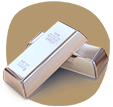
Gold
Gold is one of the most commonly used precious metals because of its natural softness and malleability. However, to create jewelry that is strong and durable, pure gold is alloyed with other metals such as Copper and Zinc that impart Gold its strength and luster in the making of jewelry.
Our jewelry is made with 10K, 14K and 18K Gold in rose, white and yellow colors depending on market requirements and consumer demands.
Gold Karat
Gold is measured in Karats (K) and divided into 24 parts. Pure Gold (Au) is m easured as 24K. 18K Gold is 18/24 parts by mass or 75% Gold, making it ideal for everyday use. Similarly, 9K gold is 9/24 parts Gold by mass or 37.5% Gold, making it a more affordable choice. Here are some more details that should be helpful:

10K gold denotes 41.7% gold purity and it contains more alloy than gold. 10K undoubtedly offers excellent value for money and is noticeably cheaper and more durable than 14K. 10K gold is a good choice for people looking for the best price!

14K Gold denotes 58.5% Gold purity, immediately increasing its value and making it a popular choice for those looking for a long-lasting piece of jewelry.
Gold Color

Yellow Gold: Gold is naturally yellow in color. However, since pure gold is very soft, it is usually alloyed with silver or copper, enhancing its natural warmth.

White Gold: To create the white‐silver color, gold is combined with Palladium and Silver or with Nickel, Copper and Zinc. White gold also needs to be coated with Platinum or Rhodium to enhance its whiteness and increase its durability and shine. White Gold jewelry may occasionally need to be re‐dipped when this coating begins to wear off.

Rose Gold: To create the rosy-pink color of rose Gold, pure Gold is combined with more copper. More the copper added to the alloy, the rosier the Gold becomes. Rose Gold does not need to be dipped or coated as the color of the allow is pure and consistent throughout.

Two -Tone / Plated Two-Tone Gold: You are likely to come across jewelry that may feature two of the colors from yellow, white and rose, which will be referred to as two-toned or two-colored Gold jewelry. Ideal for earrings, bracelets, necklaces, pendants and rings, two-color Gold can be used to symbolize the love between two people, making it is popular choice in wedding jewelry and rings. It is also considered as a good option for eternity and anniversary rings. Fusing together two different colors of Gold require more work and hence, often increase the price of the jewelry depending on the labor of love required to retain the details in its design. Plated two-tone includes rings that are solid yellow gold (or solid white gold) and part of the piece is plated with a different color. Two-tone rings made from all yellow gold are commonly plated with rhodium, the same plating used on white gold to give it that bright, white look.


Sterling Silver
Silver has been valued for centuries and at one time, it was considered even more valuable than Gold. Today, it's the most affordable of all the precious metals.
Just like Gold, pure Silver is also too soft to be used in jewelry making. Hence, it is mixed with Copper or other metals to create Sterling Silver which makes it more durable. Sterling Silver must contain at least 92.5% pure Silver, which is why it's stamped as .925. You can find this stamp on the inside of the shank of a Sterling Silver ring or stamped on the back of a pendant or other item. While Sterling Silver is harder than pure Silver, it can still be scratched very easily.
Sterling Silver can range from bright white to grayish white and can have a matte or shiny finish. Sterling Silver can be plated with Gold to change its color.
Silver tends to tarnish easily, which is why it should be stored in tarnish preventative pouches and in a cool, dry place. Jewelry made with Sterling Silver must be cleaned using mild soap and warm water and dried with a soft lint‐free cloth.




